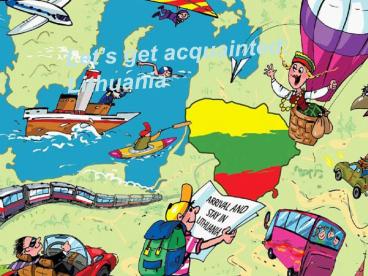Skaidre 1 - PowerPoint PPT Presentation
1 / 12
Title:
Skaidre 1
Description:
fitness club entrance 10 Euro. accommodation in a university hostel 70 Euro/month ... independence in 1990, the national men's basketball team has won the bronze ... – PowerPoint PPT presentation
Number of Views:48
Avg rating:3.0/5.0
Title: Skaidre 1
1
Lets get acquainted Lithuania
2
Where we are?
Since the 1st of May 2004 we are in the EU. In
the Centre of Europe, as determined by the French
National Geographic Institute in 1989, the
geographical centre of the continent is in the
east part of Lithuania, 25 km north of Vilnius.
The Open Air Museum of the Centre of Europe was
founded there in 1991. Lithuania's land borders
are with Latvia (610 km), Belarus (727 km),
Poland (110 km) and the Kaliningrad Region of the
Russian Federation, former East Prussia (303 km).
3
Whats the area of Lithuania?
- Area 65,200 km2 (larger than Belgium, Denmark,
the Netherlands or Switzerland).
4
Whats the population of Lithuania?
- Population 3,5 mln. more than 0,5 mln.
live in Vilnius, the capital city of Lithuania. - Ethnic composition Lithuanians (81,8), Russians
(8,1), Poles (6,9), Belarusians (1,4), Ukrainians
(1), Latvians (0,1), Jews (0,1), others
(0,7). Dominant religion catholic.
5
What language do we speak?
- Official language Lithuanian, which
belongs to the Baltic group of the Indo-European
languages. Its roots lie in Sanskrit. Currently,
only the Latvian language is closely related to
it. Lithuanian is one of the oldest European
languages.
6
What do we eat?
- Lithuanians like to eat good, tasty and
filling foods, our ancestors would say "who eats
well, works well". - One of the oldest and most fundamental staple
foods was and is the rye bread. Lithuanians
consume a lot of potatoes (the most popular
dishes potatoes dumplings, potatoes cake, potato
pancakes), meat and its by-products. Milk
products have been popular since ancient times.
Wild berries and mushrooms are very often used in
Lithuanian cuisine, as many people love gathering
of mushrooms and berries in the forests. Mead
(midus, honey liquor) and beer (alus) are
ceremonial and traditional drinks. - Nowadays in the city there are lots of cafes
with Italian, German, Irish, Turkish, Chinese,
Indian and other cuisines of the World.
7
In what currency and how much do we pay?
- Currency Litas (pegged to Euro since
February 2, 2002 at 1 EUR 3,4528 LTL). - Living expenses
- dinner in a café Euro
- nightclub entrance 5-6 Euro
- beer 1,5 2 Euro/0,5 l
- fitness club entrance 10 Euro
- accommodation in a university hostel 70
Euro/month
8
Whats Lithuanian economy profile?
- Resources timber, peat, gravel, quartz and
construction sand, dolomite, clay, limestone,
brick clay, mineral water. - Economy light industry, diary and meat
industry, electrical engineering, machinery,
energy industry, logistic and other service
trades. - Export textile, chemicals, diary and meat
products, mineral products, machinery, and
electrical appliances. - Import oil, natural gas, machinery, and
electrical appliances.
9
What about Lithuanian climate and nature?
- Climate between maritime and continental,
-4,9 o C (January) and 17,2 o C (July). - Lithuania has more than 4000 lakes.
- Lithuania is a green pearl of nature being made
up of more than 4000 lakes and over 700 rivers
(the longest river is Nemunas total length 937
km, length in Lithuania 475 km), extensive
primeval forests (forests cover 30 of the
Lithuanian territory), mysterious marshes and
green expanses. Nature parks and resorts are
spread all over the country in the neighbourhood
of all the rivers and lakes.
10
What do we celebrate?
- New Year (January 1)
- Independence Day, Restoration of the Lithuanian
State in 1918 (February 16) - Restoration of Lithuanias Independence in 1990
(March 11) - Catholic Easter Sunday and Monday (March or
April) - International Labour Day (May 1)
- Mother's Day (1st Sun. of May)
- Day of Mourning and Hope (June 14)
- St. Johns Day (June 24)
- Statehood Day, Crowning of Mindaugas in 1253
(July 6) - Assumption of the Blessed Virgin Mary (August 15)
- All Saints Day (November 1)
- Christmas (December 25-26)
11
Do you kow that?
- From 1392 to 1430, Lithuania was the largest
state in Europe - Lithuania reached the peak of its power and
glory under the rule of the Grand Duke Vytautas,
at the end of the 14th and the beginning of the
15th centuries. By the size of its territory,
Lithuania was one of the largest states in Europe
at that time. The western border of the Grand
Duchy of Lithuania was delineated by the Baltic
Sea, while the eastern border - by the Black Sea. - Lithuania was the last European country to accept
Christianity (in 1387). - Vilnius Historic Centre, the Curonian Spit and
Kernave Archaeological Site are inscribed into
the UNESCO World Heritage List.
12
- UNESCO declared Cross-mastering and Sacral Arts
as well as the Lithuanian Song Festival as an
exceptionally valuable cultural and public
phenomenon in the context of global culture. - Lithuanian gold is amber
- Since ancient times amber has been thought of as
Lithuania's gold. Pieces of amber are still
washed up on the beaches after a storm. - Lithuanians are very good basketball players
- Since the 1930 basketball is considered to be the
national sport of Lithuania. After regaining
independence in 1990, the national men's
basketball team has won the bronze medals in each
of its three Olympic appearances - Barcelona
(1992), Atlanta (1996) and Sydney Olympics in
2000.































